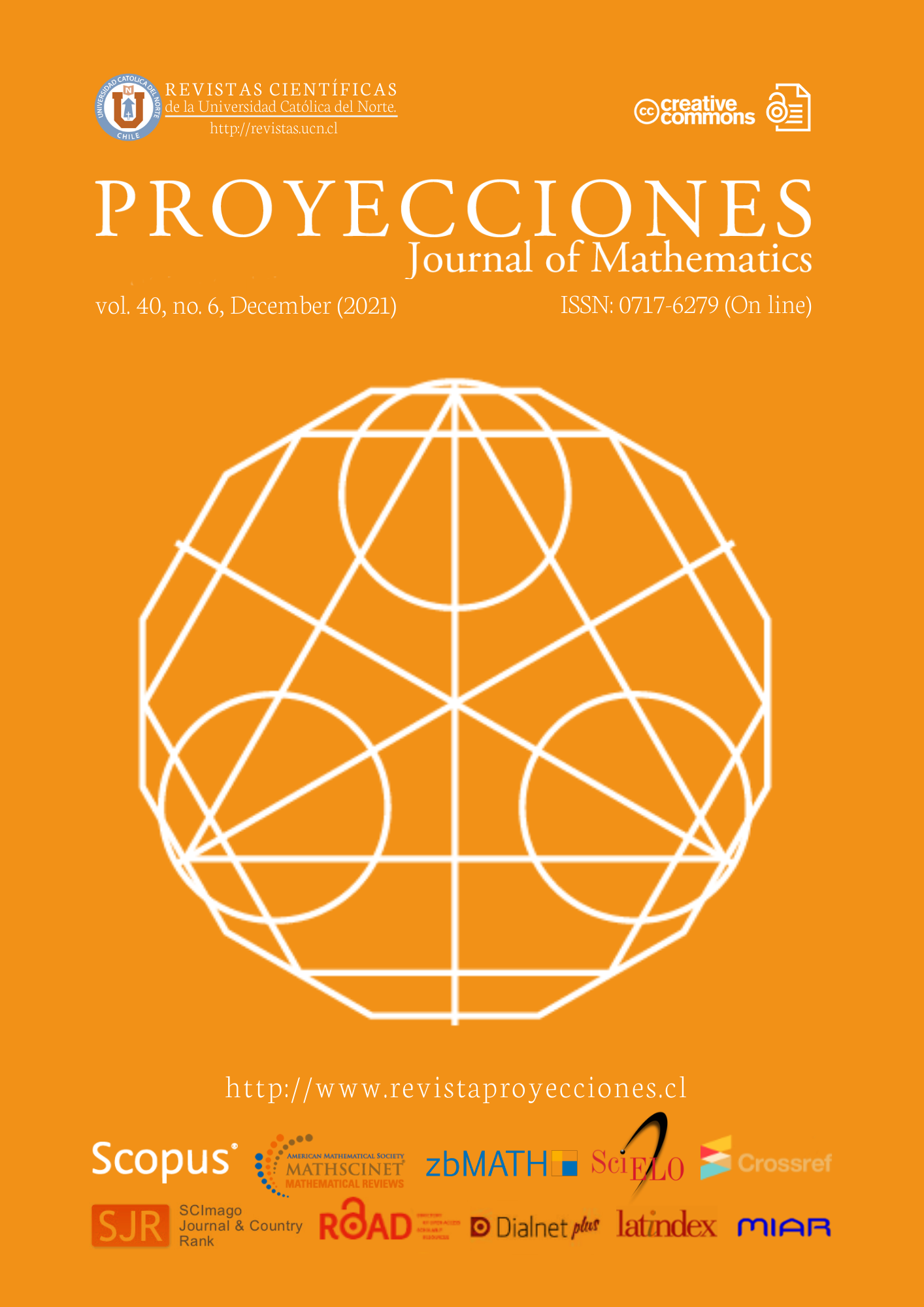Domination in the entire nilpotent element graph of a module over a commutative ring
DOI:
https://doi.org/10.22199/issn.0717-6279-4737Keywords:
Bondage number, Domination number, Entire nilpotent element graph, Nilpotent elements, Non-nilpotent elementsAbstract
Let R be a commutative ring with unity and M be a unitary R module. Let Nil(M) be the set of all nilpotent elements of M. The entire nilpotent element graph of M over R is an undirected graph E(G(M)) with vertex set as M and any two distinct vertices x and y are adjacent if and only if x + y ∈ Nil(M). In this paper we attempt to study the domination in the graph E(G(M)) and investigate the domination number as well as bondage number of E(G(M)) and its induced subgraphs N(G(M)) and Non(G(M)). Some domination parameters of E(G(M)) are also studied. It has been showed that E(G(M)) is excellent, domatically full and well covered under certain conditions.
References
S. Akbari, D. Kiani, F. Mohammadi, and S. Moradi, “The total graph and regular graph of a commutative ring”, Journal of pure and applied algebra, vol. 213, no. 12, pp. 2224–2228, 2009.
M. M. Ali, “Idempotent and nilpotent submodules of multiplication modules”, Communications in algebra, vol. 36, no. 12, pp. 4620–4642, 2008.
D. D. Anderson and M. Naseer, “Beck′s coloring of a commutative ring”, Journal of algebra, vol. 159, no. 2, pp. 500–514, 1993.
D. F. Anderson and A. Badawi, “The total graph of a commutative ring”, Journal of algebra, vol. 320, no. 7, pp. 2706–2719, 2008.
D. F. Anderson and P. S. Livingston, “The zero-divisor graph of a commutative ring”, Journal of algebra, vol. 217, no. 2, pp. 434–447, 1999.
F. W. Anderson and K. R. Fuller, Rings and categories of modules, 2nd ed. New York. NY: Springer, 1992.
I. Beck, “Coloring of commutative rings”, Journal of algebra, vol. 116, no. 1, pp. 208–226, 1988.
G. Chartrand and P. Zhang, Introduction to graph theory. New Delhi (India): Tata McGraw-Hill, 2006.
J. Goswami, “Domination in the total graph of a module with respect to singular submodule”, submitted.
J. Goswami, K. K. Rajkhowa, and H. K. Saikia, “Total graph of a module with respect to singular submodule”, Arab journal of mathematical sciences, vol. 22, no. 2, pp. 242–249, 2016.
J. Goswami and H. K. Saikia, “On the Line graph associated to the total graph of a module”, Matematika, vol. 31, no. 1, pp. 7-13, 2015.
F. Harary, and T. W. Haynes, “Double domination in graphs”, Ars combinatoria, vol. 55, pp. 201-213, 2000.
T. W. Haynes, S. T. Hedetniemi, and P. J. Slatar, Fundamental of domination in graphs. New York, NY: Marcel Dekker, 1998.
T. W. Haynes, S. T. Hedetniemi, and P. J. Slatar, Domination in graphs: advanced topics. Marcel Dekker, 2000.
J. Lambek, Lectures on rings and modules. Waltham (MA): Blaisdell, 1966.
D. A. Mojdeh and A. M. Rahimi, “Dominating sets of some graphs associated to commutative rings”, Communications in algebra, vol. 40, no. 9, pp. 3389–3396, 2012.
M. Shabani, A. Y. Darani, and S. E. Atani, “The entire nilpotent element graph of a module over a commutative ring”, submitted.
A. Shariatinia and A. Tehranian, “Domination number of total graph of module”, Algebraic structures and their applications, vol. 2, no. 1, pp. 1-8, 2015.
M. H. Shekarriz, M. H. Shirdareh Haghighi, and H. Sharif, “On the total graph of a finite commutative ring”, Communications in algebra, vol. 40, no. 8, pp. 2798–2807, 2012.
T. Tamizh Chelvam and T. Asir, “Domination in the total graph of a commutative ring”, Journal of combinatorial mathematics and combinatorial computing, vol. 87, pp. 147-158, 2013.
Published
How to Cite
Issue
Section
Copyright (c) 2021 Jituparna Goswami, Masoumeh Shabani

This work is licensed under a Creative Commons Attribution 4.0 International License.
-
Attribution — You must give appropriate credit, provide a link to the license, and indicate if changes were made. You may do so in any reasonable manner, but not in any way that suggests the licensor endorses you or your use.
- No additional restrictions — You may not apply legal terms or technological measures that legally restrict others from doing anything the license permits.












